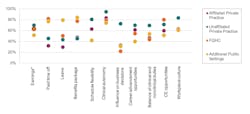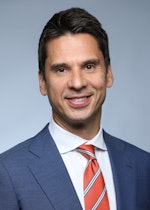Survey results: Does new dentist career satisfaction vary by practice type?
For at least a decade, two major trends affecting dental practice structure have been impossible to miss. One is the decline of practice ownership among dentists and the number of dentists in solo practice, and the other is the increasing affiliation of dentists, especially young dentists, with dental support organizations (DSOs) and other group practices.
Shifts in dental practice modality have important implications for the delivery of dental care in the US and for dentists’ attitudes and perceptions regarding their careers. To measure the relationship between practice modality and dentists’ career satisfaction, the American Dental Association Health Policy Institute (HPI) conducted a study of trending practice transition data among US dentists, as well as a survey asking dentists to rank their satisfaction with various aspects of their careers in relation to their past and current practice types. HPI focused on new dentists—dentists up to 10 years out of dental school. Some key takeaways tell us what to expect in the future as dentists identify their career priorities and seek practice types that they believe will provide the benefits and values they want.
New dentists tend to stay put when it comes to practice size and DSO status
As of 2022, 17% of new dentists were in solo practice, 47% were in single location practices with more than one dentist, and 36% were in multilocation practices of various sizes. Of this 36%, 16% were in practices with more than 100 locations. Among this new dentist group, the majority do not transition to a different type of practice in a five-year timeframe.
For example, more than half of solo practitioner dentists in 2016 (57%) remained in solo practice five years later. The same held true among dentists in multisite group practices: 54% of dentists in group practices with 100 or more locations still worked in the same size practice after five years. This pattern of inertia is also true for DSO status: 57% of DSO dentists in 2016 remained in DSOs in 2021, and 91% of non-DSO dentists in 2016 remained unaffiliated with DSOs in 2021.
When new dentists do transition to a different practice size or type, the transition tends to be a downsize, meaning dentists go to a practice that has fewer locations than their original practice. However, transition to solo practice is not an inevitability, with fewer than 14% of dentists in multisite group practices moving to solo practice after a five-year period.
Dentists prefer unaffiliated practices, but no practice type offers everything they want
A survey of new dentists reveals that when they leave any type of practice for a new one, career satisfaction goes up. However, dentists indicated an overall preference for practices that are unaffiliated with DSOs or multisite group practice. New dentists who left affiliated private practice for a different type of practice reported the highest jump in satisfaction with various aspects of their careers. In particular, dentists who were “satisfied” or “very satisfied” in earnings and paid time off increased from 35% to 73% and from 21% to 48%, respectively, after leaving an affiliated private practice.
The most remarkable jumps were for satisfaction with clinical autonomy, which rose from 32% to 94%, and for satisfaction with influence on practice business decisions, which rose from 7% to 75%. These results indicate dentists prefer to have a greater say in the clinical and nonclinical aspects of their careers and this influence is more likely to be found in unaffiliated private practice.
Nevertheless, unaffiliated private practice has its shortcomings. Among dentists who intend to leave unaffiliated practice, only one-third said they were satisfied with paid time off and 28% said they were satisfied with their benefits package. See figure 1 for career satisfaction by new dentists’ current practice setting type.
Level of education debt is not that influential over practice decisions
It’s been said that new dentists choose group practice due to their debt burden after graduation from dental school. However, debt levels among survey participants were nearly the same among dentists in affiliated private practice, unaffiliated private practice, and federally qualified health centers (FQHCs), suggesting that debt levels were not a significant influence on dentists’ choice of practice type.
Practice modality trends are unlikely to slow down anytime soon. More research is needed to understand how the dental profession and dental care delivery will be affected by the growth in consolidated dentistry.
Read HPI’s full report, “Practice Setting Transitions and Career Satisfaction among New Dentists.”
Note: The results are for dentists who graduated from dental school between 2013 and 2022. It combines “satisfied” and “very satisfied” responses. Affiliated private practice is a practice that belongs to a multisite group practice and/or a dental support organization (DSO). An unaffiliated private practice is one that does not belong to a multisite group practice or DSO. Additional public settings: practices are affiliated with the US Army, Veterans Affairs, or Public Health Service, and hospitals. *Satisfaction with earnings among dentists in affiliated private practice settings and dentists in FQHC settings was nearly equal and therefore “affiliated private practice” is not visible in the “earnings” column.
Editor's note: This article appeared in the April 2024 print edition of Dental Economics magazine. Dentists in North America are eligible for a complimentary print subscription. Sign up here.
Marko Vujicic, PhD, is the chief economist and vice president of the American Dental Association Health Policy Institute. He is a health-care policy thought leader and researcher focusing on providing data-driven insights on the future of dentistry. Contact him at [email protected].










